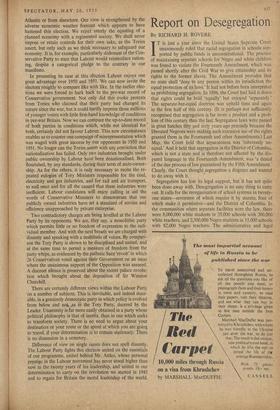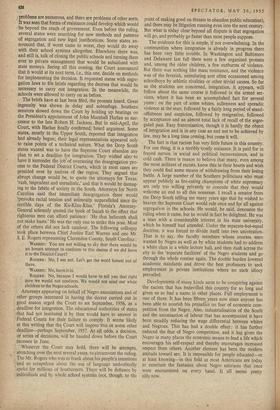Report on Desegregation
By RICHARD H. ROVERE IT is just a year since the United States Supreme Coui.t unanimously ruled that racial segregation in schools sup- ported by public funds is unconstitutional. The practice of maintaining separate schools for Negro and white children was found to violate the Fourteenth Amendment, which was passed shortly after the Civil War to give citizenship and its rights to the former slaves. The Amendment provides that no state shall 'deny to any person within its jurisdiction the equal protection of its laws.' It had not before been interpreted as prohibiting segregation. In 1896, the Court had laid it down that rights could be held 'equally' but enjoyed 'separately.' The separate-but-equal doctrine was upheld time and again in the first half of this century. (It is perhaps not sufficiently recognised that segregation is far more a product and a prob- lem of this century than the last. Segregation laws were passed in great batches fifty and sixty years ago precisely because the liberated Negroes were making such extensive use of the rights granted them in the Fourteenth and other Amendments.) Last May, the Court held that separateness was 'inherently un- equal.' And it held that segregation in the District of Columbia. which is not a state and is therefore not affected by the dis- puted language in the Fourteenth Amendment, was 'a denial of the due process of law guaranteed by the Fifth Amendment.' Clearly, the Court thought segregation a disgrace and wanted to do away with it.
Segregation has lost its legal support, but it has not quite bden done away with. Desegregation is no easy thing to carry out. It calls for the reorganisation of school systems in twenty- one states—seventeen of which require it by statute, four of which make it permissive—and the District of Columbia. In the communities where separate facilities were the law, there were 8,000,000 white students in 35,000 schools with 300,000 white teachers, and 2,500,000 Negro students in 15,000 schools with 82,000 Negro teachers. The administrative and legal problems are numerous, and there are problems of other sorts. It was seen that forms of resistance could develop which would be beyond the reach of government. Even before the ruling, several states were searching for new methods and patterns of segregation and new legal justifications. Some states an- nounced that, if worst came to worst, they would do away with their school systems altogether. Elsewhere there was, and still is, talk of closing the public schools and turning them over to private management that would be subsidised with state moneys. Seeing all this coming, the Court announced that it would at its next term, i.e., this one, decide on methods for implementing the decision. It requested states with segre- gation laws to file briefs regarding the decrees that would be necessary to carry out integration. In the meanwhile, the schools were allowed to carry on as before. .
The briefs have at last been filed, the protests heard. Great ingenuity was shown in delay and subterfuge. Southern senators slowed down the Court by holding up hearings on the President's appointment of John Marshall Harlan as suc- cessor to the late Robert H. Jackson. But in mid-April, the Court, with Harlan finally confirmed, heard argument. Some states, mostly in the. Upper South, reported that integration had already begun; their legal representatives appeared only to raise points of a technical nature. What the Deep South states wanted was to have the Supreme Court abandon any plan to set a deadline for integration. They wished also to have it 'surrender the job of overseeing the desegregation pro- cess to the Federal District Courts, which in most cases are presided over by natives of the region. They argued that abrupt change would be, to quote the attorneys for Texas, 'rash, imprudent and unrealistic,' and that it would be damag- ing to the fabric of society in the South. Attorneys for North Carolina said that immediate desegregation there would `provoke racial tension and animosity unparalleled since the terrible days of the Ku-Klux-Klan.' Florida's Attorney- General solemnly quoted the book of Isaiah to the effect that righteous men can afford patience : 'He that believeth shall not make haste.' He was the only one to strike this pose. Most of the others did not lack candour. The following colloquy took place between Chief Justice Earl Warren and one Mr, S. E. Rogers representing Clarendon County, South Carolina : WARREN: You are not willing to (ay that there would be an honest attempt to conform to this decree if we did leave it to the District Court?
ROGERS : No, I am not. Let's get the word honest out of there.
WARREN : No, leave it in.
ROGERS : No, because I would have to tell you that right now we would not conform. We would not send our white children to the Negro schools.
Attorneys appearing on behalf of Negro associations and of other groups interested in having the decree carried out in good season urged the Court to set September, 1956, as a deadline for integration. The educational authorities of states that had not instituted it by then would have to answer in Federal Courts for their failure to comply. It seems likely at this writing that the Court will impose this or some other deadline—perhaps September, 1957. At all odds, a decision, or series of decisions, will be handed down before the Court recesses in June.
Whatever the Court may hold, there will be attempts, stretching over the next several years, to circumvent the ruling. The Mr. Rogers who was so frank about his people's intentions and so scrupulous about the use of language undoubtedly spoke for millions of Southerners. There will be defiance by individuals and by whole school systems (not, though, to the point of making good on threats tb abandon public education). and there may be litigation running even into the next century. But what is today clear beyond all dispute is that segregation will go, and probably go faster than most people suppose.
The evidence for this is ample, if not overwhelming. In the communities where integration is already in progress there has been very little trouble. In Washington and Baltimore and Delaware last fall there were a few organised protests and, among the older children, a few outbursts of violence. But there was nothing like mass resistance, and the violence was of the feverish, unenduring sort often occasioned among schoolboys by athletic rivalries or other trivial causes. So far as the students are concerned, integration, it appears, will follow about the same course it followed in the armed ser- vices, where it has been an accomplished fact for several years : on the part of some whites, sullenness and sporadic violence at the start, followed by a fairly long period of stand- offishness and suspicion, followed by resignation, followed by acceptance and an almost total lack of recall of the segre- gated past. Easy fraternisation, though it .is hardly the object of integration and is in any case an end not to be achieved by law, may be a long time coming, but come it will.
The fact is that racism has very little future in this country. For one thing, it is a terribly costly nuisance. It is paid for in frayed nerves, in social and political inconvenience, and in cold cash. There is reason to believe• that many, even among the most militant of racists, know this in their hearts and wish they could find some means of withdrawing from their losing battle. A large number of the Southern politicians who must appear publicly as fire-eating champions of white supremacy are only too willing privately to concede that they would welcome an end to all this nonsense. I recall a senator from the Deep South telling me many years ago that he wished to heaven the Supreme Court would rule once and for all against segregation in the schools. He would, he said, denounce the ruling when it came, but he would in fact be delighted. He was a man with a considerable interest in his state university, which he himself had attended. Under the separate-but-equal doctrine, it was forced to divide itself into two universities. That is to say, the faculty members whose courses were wanted by Negro as well as by white students had to address a white class in a white lecture hall, and then dash across the city to the 'separate facilities' of the Negro students and go through the whole routine again. The double burden lowered academic standards and drove the best professprs to seek employment in private institutions where no such idiocy prevailed.
Developments of many kinds seem to be conspiring against the racism that has bedevilled this country for so long and given us. so bad a name in other places. Full employment is one of them. It has been fifteen years now since anyone has been able to nourish his prejudice on fear of economic com- petition from the Negro. Also, industrialisation of the South and the unionisation of labour that has accompanied it have been steadily reducing the wage differential between whites and Negroes. This has had a double effect : it has further reduced the fear of Negro competition, and it has given the Negro in many places the economic means to lead a life which encourages his self-respect and thereby encourages increased respect from others. Another element has been the modern attitude toward sex. It is impossible for people educated—or at least knowing—in this field as most Americans are today to entertain the fantasies about Negro satiriasis that once were encountered on every hand. It all seems pretty silly now.












































 Previous page
Previous page